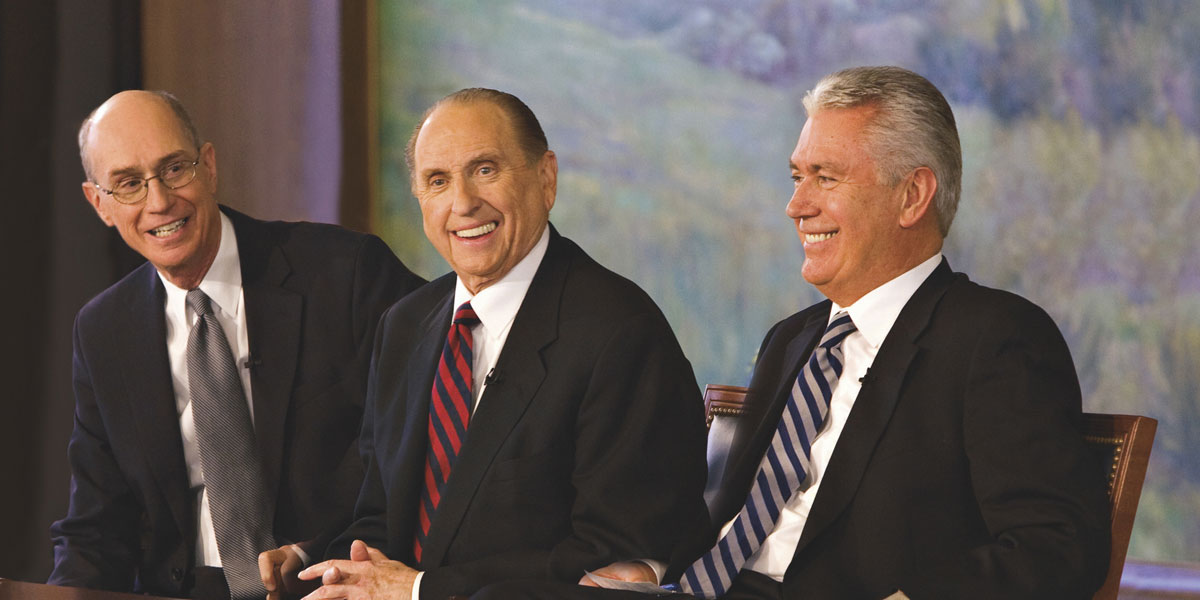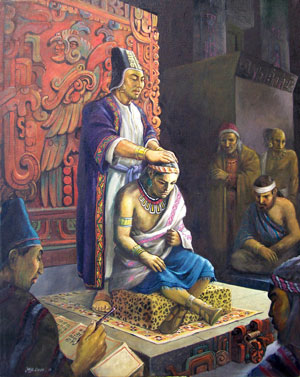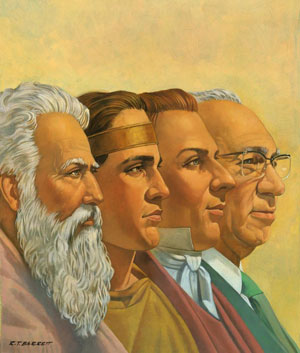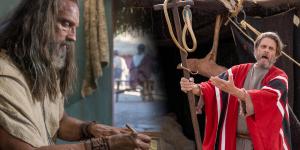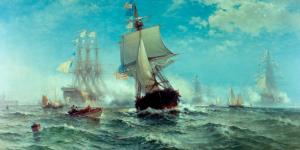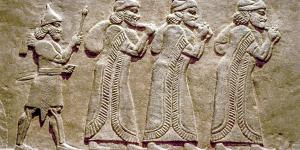You are here
Why Do We Need Prophets?

3 Nephi 5:1
The Know
Prophets today fill many functions. They speak for the Lord and reveal His will to us;1they testify of Christ and teach His gospel;2they have the gift of seership and use it to bless others (see Doctrine and Covenants 21:1), all while presiding over the church (see Doctrine and Covenants 107:91–92). Prophets in the Book of Mormon also filled many of these functions, as seen when one carefully looks at the Book of Mormon in its ancient context.3
The prophet speaks for the Lord and reveals the Lord’s will
In ancient Israel and the Book of Mormon, prophets often received their call as they were admitted into God’s divine council and received instruction from Him.4 They would then return to the people and tell them what God had said.5 In this way, prophets are messengers from God to His children.6 Father Lehi, Alma, and Nephi the son of Helaman had experiences like this, where they entered God’s throne room, received knowledge from God, and shared it with humanity.7 In both Mesoamerica and the Book of Mormon, there were occasions where prophets or holy men would fall down as if they were dead, have a vision of God, and then repeat what God had told them.8 In these ways, the prophets spoke for the Lord and revealed His will to humanity.9
The prophet testifies of Jesus Christ and teaches the gospel
Prophets in the Book of Mormon testified plainly of Christ and taught people His gospel.10 Because they were drawing from the Israelite tradition, teaching about Christ would have been an important part of what some prophets did.11 As Jewish scholar Daniel Boyarin has noted, teachings that seem Christian were actually common in ancient Israel, “the notion of a dual godhead with a Father and a Son, the notion of a Redeemer, who himself, will be both God and man, and the notion that this Redeemer would suffer and die as part of the salvific process” were part of ancient Israelite religion.12
Boyarin also noted that “some of these ideas, the Father/Son godhead and the suffering savior, for instance, have deep roots in the Hebrew Bible as well and may be among some of the most ancient ideas about God and the world the Israelites held.”13 Because of this, it is not surprising that prophets in the Book of Mormon, like prophets today, bore powerful testimony of Christ and His gospel.
The prophet is a seer
In both ancient Israel and ancient Mesoamerica, one often sees examples of seers. In the Old Testament, Samuel the prophet is referred to as a seer (1 Samuel 9:9), as is Gad (2 Samuel 24:11), and Iddo (2 Chronicles 9:29), among others.14 In the Book of Mormon, one also sees seers as well, and they appear to be distinguished by the use of seer stones (see Mosiah 8:13–18).
Stones like this were used in Mesoamerica as well.15 Maya scholar Mark Wright has noted that one burial from the Middle Classic period “contained ‘five peculiar quartz stones … probably used in divination rituals.’ This burial was likely that of a royal priest or shaman rather than of a ruler, as these stones were found along with other paraphernalia common to ritual specialists.”16
The prophet presides over the Church
The high priest Alma, whom an angel called as prophet (see Alma 8:20), also seems to have presided over the church as a whole. He visits locations outside of Zarahelma that have their own local leadership (see Alma 6:1) and may have presided over these local branches.17 This is similar to Moses, who seems to have presided over the whole church, including leaders over smaller units, such as the seventy elders (see Numbers 11:24–29). It is therefore appropriate that Alma is specifically compared to Moses, because it reminds the reader that they had similar roles in the church (Alma 45:19).
There is also a similarity in the pre-Columbian American world. In Mesoamerica, during the post-Classic period, a ruler known as a halach uinic (“true man”) had political authority, but also had religious authority, like Alma did. As John S. Henderson has noted “the halach uinic had important religious roles, and could be referred to as ‘bishop.’”18 He presided over other towns who were loyal to him, like Alma did.
The Why
Prophets today speak for the Lord and reveal His will to us, testify of Christ and teach His gospel, have the gift of seership, and preside over the church, just as prophets in the Book of Mormon did. This does not mean that prophets in the Book of Mormon are exactly the same as prophets today. However, the general roles appear to have remained similar over time.19 Today, as in ancient times, prophets receive instruction from God and teach what they learn to God’s children. They teach us about the Father and the Son, and that Christ died for humanity.
We sustain modern prophets as prophets, seers, and revelators and they reveal truths from the past, present, and future, like seers in the Book of Mormon did.20 The prophets today also take special care to tend to local congregations as they preside over the entire church, just as Book of Mormon prophets did.
As Joseph Fielding McConkie and Robert Millet have noted, “The nation of Israel was formed by God with a prophet, chosen by him, to stand at its head. The Law of Moses, which governed the nation, was given by revelation and could only be amended in the same manner. It was the divine intent that Israel always be led by prophets.”21 The same is true today.
Further Reading
Mark Alan Wright, “Nephite Daykeepers: Ritual Specialists in Mesoamerica and the Book of Mormon,” in Ancient Temple Worship: Proceedings of the Expound Symposium, 14 May 2011, ed. Matthew B. Brown, Jeffrey M. Bradshaw, Stephen D. Ricks, and John S. Thompson (Salt Lake City and Orem, UT: Eborn Books and Interpreter Foundation, 2014), 244–246.
John W. Welch, “The Calling of Lehi as a Prophet in the World of Jerusalem,” in Glimpses of Lehi’s Jerusalem, ed. John W. Welch, David Rolph Seely, and Jo Ann H. Seely (Provo: FARMS, 2004), 421–448.
Steven C. Walker, “Seer,” in The Encyclopedia of Mormonism, ed. Daniel H. Ludlow (New York, NY: Macmillan, 1992), 3:1292–1293.
- 1. See Doctrine and Covenants 1:38 21:4–5 43:2 68:3–4.
- 2. See Doctrine and Covenants 20:21–26 Mosiah 13:33.
- 3. See Book of Mormon Central, “What Does the Book of Mormon Teach about Prophets? (Helaman 13:4),” KnoWhy 284 (March 8, 2017).
- 4. See Book of Mormon Central “How Did God Call His Prophets in Ancient Times? (1 Nephi 15:8),” KnoWhy 17 (January 22, 2016); Book of Mormon Central, “Why is There Temple Imagery in Helaman 10? (Helaman 10:8),” KnoWhy 17 (January 22, 2016).
- 5. For more on this, see John W. Welch, “The Calling of a Prophet,” in First Nephi, The Doctrinal Foundation, ed. Monte S. Nyman and Charles D. Tate Jr. (Provo, UT: Religious Studies Center, Brigham Young University, 1988), 35–54. See also Blake T. Ostler, “The Throne-Theophany and Prophetic Commission in 1 Nephi: A Form-Critical Analysis,” BYU Studies 26/4 (1986): 67–95, John W. Welch, “The Calling of Lehi as a Prophet in the World of Jerusalem,” in Glimpses of Lehi’s Jerusalem, ed. John W. Welch, David Rolph Seely, and Jo Ann H. Seely (Provo: FARMS, 2004), 421–448.
- 6. Hugh Nibley, The Prophetic Book of Mormon, The Collected Works Hugh Nibley, Volume 8 (Salt Lake City and Provo, UT: Deseret Book and FARMS, 1989), 12.
- 7. See Book of Mormon Central, “Why is There Temple Imagery in Helaman 10? (Helaman 10:8)” KnoWhy 181 (January 22, 2016).
- 8. For a full treatment of this, see Mark Alan Wright, “‘According to Their Language, unto Their Understanding’: The Cultural Context of Hierophanies and Theophanies in Latter-day Saint Canon,” Studies in the Bible and Antiquity 3 (2011): 51–65.
- 9. See Book of Mormon Central, “Why Does the Lord Speak to Men “According to Their Language”? (2 Nephi 31:3),” KnoWhy 258 (January 6, 2017).
- 10. ]For two significant examples of this, see Rodney Turner, “Two Prophets: Abinadi and Alma,” in The Book of Mormon, Part 1: 1 Nephi to Alma 29, ed. Kent P. Jackson, Studies in Scripture: Volume 7 (Salt Lake City, UT: Deseret Book, 1987), 240–259.
- 11. See Book of Mormon Central, “Did Pre-Christian Prophets Know about Christ? (1 Nephi 10:17),” KnoWhy 12 (January 15, 2016).
- 12. Daniel Boyarin, The Jewish Gospels: The Story of the Jewish Christ (New York, NY: The New Press, 2012), 158.
- 13. Boyarin, The Jewish Gospels, 158.
- 14. See, for example, 1 Samuel 9:11, 19; 2 Samuel 15:27; 2 Kings 17:13; Micah 3:7; Amos 7:12; Isaiah 30:10.
- 15. See, for example, Marc G. Blainey, “Techniques of Luminosity: Iron-Ore Mirrors and Entheogenic Shamanism among the Ancient Maya,” in Manufactured Light: Mirrors in the Mesoamerican Realm, ed. Emiliano Gallaga M. and Marc G. Blainey (Boulder, CO: University Press of Colorado, 2016), 179–206, and John J. McGraw, “Stones of Light: The Use of Crystals in Maya Divination,” in Manufactured Light, 207–227.
- 16. Mark Alan Wright, “Nephite Daykeepers: Ritual Specialists in Mesoamerica and the Book of Mormon,” in Ancient Temple Worship: Proceedings of the Expound Symposium, 14 May 2011, ed. Matthew B. Brown, Jeffrey M. Bradshaw, Stephen D. Ricks, and John S. Thompson (Salt Lake City and Orem, UT: Eborn Books and Interpreter Foundation, 2014), 245.
- 17. Brant A. Gardner, Second Witness: Analytical and Contextual Commentary on the Book of Mormon, 6 vols. (Salt Lake City, UT: Greg Kofford Books, 2007), 4:149.
- 18. See John S. Henderson, The World of the Ancient Maya, 2nd edition (Ithaca, NY: Cornell University Press, 1997), 46.
- 19. Joseph Fielding McConkie, “Priesthood among the Nephites,” Book of Mormon Reference Companion, ed. Dennis L. Largey (Salt Lake City, UT: Deseret Book, 2003), 656.
- 20. See Book of Mormon Central, “Why Is A Seer Greater Than A Prophet? (Mosiah 8:15),” KnoWhy 86 (April 26, 2016).
- 21. Joseph Fielding McConkie and Robert L. Millet, Doctrinal Commentary on the Book of Mormon, 4 vols. (Salt Lake City, UT: Bookcraft, 1987–1992), 2:270.
KnoWhy Citation
Related KnoWhys
Subscribe
Get the latest updates on Book of Mormon topics and research for free

